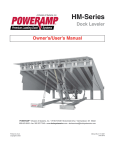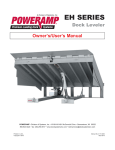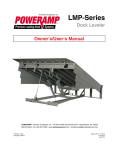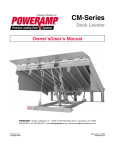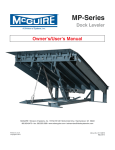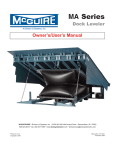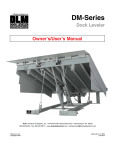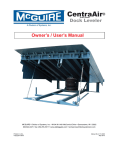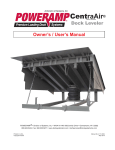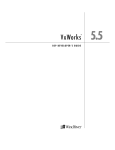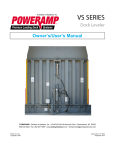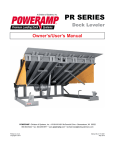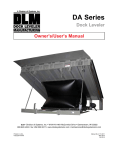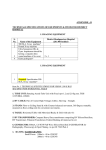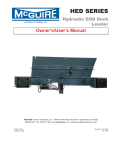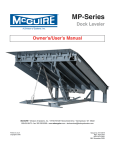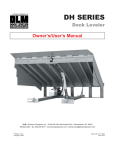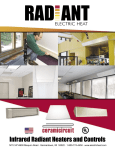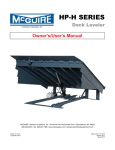Download Poweramp LMP Manual Dec2014
Transcript
LMP-Series Dock Leveler Owner’s/User’s Manual POWERAMP • Division of Systems, Inc. • W194 N11481 McCormick Drive • Germantown, WI 53022 800.643.5424 • fax: 262.257.7399 • www.docksystemsinc.com • [email protected] Printed in U.S.A. Copyright © 2014 Manual No. 4111-0013 December 2014 Table of Contents Page Safety Recognize Safety Information ............................................................. General Operational Safety Precautions ............................................ Operational Safety Precautions........................................................... Maintenance Safety Precautions ......................................................... Safety Decals ......................................................................................... Owner’s/User’s Responsibilities ......................................................... 1 1 2 4 5 6 Introduction General Information .............................................................................. 7 Dock Leveler Stock Specifications ..................................................... 7 Component Identification ..................................................................... 8 Installation Prepare Pit ............................................................................................. 9 Prepare Dock Leveler .......................................................................... 10 Install Dock Leveler ............................................................................ 12 Operation Theory .................................................................................................. Operating Instructions ....................................................................... Ramp Loading/Unloading Instructions ....................................... End Loading/Unloading Instructions........................................... 17 18 19 20 Maintenance Service Dock Leveler Safely .............................................................. 21 Periodic Maintenance ......................................................................... 22 Adjustments Adjust Lift Arm Spring and Lip Assist Spring Tension .................. 24 NON-Adjustable Lip Stop .................................................................. 26 Troubleshooting Troubleshooting .................................................................................. 27 Parts Hold-Down Mechanism ...................................................................... Frame Components ............................................................................ Platform Components ........................................................................ Toe Guard/Weather Seal—Optional .................................................. 29 30 32 34 Miscellaneous Customer Information ........................................................................ 37 Warranty................................................................................ Back Cover SAFETY Recognize Safety Information General Operational Safety Precautions Safety-Alert Symbol The Safety-Alert Symbol identifies important safety messages on equipment, safety signs, in manuals, or elsewhere. When you see this symbol, be alert to the possibility of personal injury or death. Follow the instructions in the safety message. Read and understand the operating instructions and become thoroughly familiar with the equipment and its controls before operating the dock leveler. Never operate a dock leveler while a safety device or guard is removed or disconnected. The use of the word DANGER signifies the presence of an extreme hazard or unsafe practice which will most likely result in severe injury or death. The use of the word WARNING signifies the presence of a serious hazard or unsafe practice which may result in serious injury or death. The use of the word CAUTION signifies possible hazard or unsafe practice which could result in personal injury. IMPORTANT The use of the word IMPORTANT is to draw attention to a procedure that needs to be followed to prevent machine damage. Never remove DANGER, WARNING, or CAUTION signs or decals on the equipment unless replacing them. on Z ng ati e er Op era Op g tin ne Zo DO NOT activate the equipment until all unauthorized personnel in the area have been warned and have moved outside the operating zone. Remove any tools or foreign objects from the operating zone before starting. Keep the operating zone free of obstacles that could cause a person to trip or fall. 4111-0013 — December 2014 1 SAFETY Operational Safety Precautions Learn the safe way to operate this equipment. Read and understand the manufacturer’s instructions. If you have any questions, ask your supervisor. Stay clear of dock leveling device when transport vehicle carrier is entering or leaving area. Chock/restrain all transport vehicles carriers. Never remove the wheel chocks until loading or unloading is finished and transport vehicle driver has been given permission to drive away. Do not move or use the dock leveling device if anyone is under or in front of it. Do not use a broken or damaged dock leveling device. Make sure proper service and maintenance procedures have been performed before using. Keep hands and feet clear of pinch points. Avoid putting any part of your body near moving parts. Make sure lip overlaps onto transport vehicle at least 4 in. (102 mm). Keep a safe distance from both side edges. 2 4111-0013 — December 2014 SAFETY Do not use dock leveling device if transport vehicle is too high or too low. Do not overload the dock leveling device. Do not operate any equipment while under the influence of alcohol or drugs. Do not leave equipment or material unattended on dock leveling device. 4111-0013 — December 2014 3 SAFETY Maintenance Safety Precautions DO NOT grind or weld if hydraulic fluid or other flammable liquid is present on the surface to be ground or welded Always post safety warnings and barricade the work area at dock level and ground level to prevent unauthorized use of the unit before maintenance is complete. DO NOT grind or weld if uncontained hydraulic fluid or other flammable liquid is present. Stray sparks can ignite spills or leaks near the work area. Always clean up the oil leaks and spills before proceeding with grinding or welding. Always keep a fire extinguisher of the proper type nearby when grinding or welding. Failure to follow these instructions may result in serious personal injury or death. ALWAYS stand clear of dock leveler lip when working in front of the dock leveler. Failure to do this may result in serious personal injury or death. PLACARD 1751-0875 MUST PLACED IN CLOSE PROXIMITY AND IN CLEAR VIEW OF THE LEVELER The platform maintenance prop must be in the “service” (upright) position when working under the dock leveler. For maximum protection, use an OSHA approved locking device to lock the maintenance prop in the service position. Only the person servicing the equipment should have the key to unlock the device. O P E R AT I N G ! DANGER INSTRUCTIONS ! Read and follow all instructions, warnings and maintenance schedules in the manual and on placards. ! Operation and servicing of dock leveler is restricted to trained personnel. ! Always chock transport vehicle wheels or engage vehicle restraint and set parking brakes before operating dock leveler or beginning to load or unload. ! Before activating dock leveler, ensure lip avoids contact with transport vehicle sides and cargo. If lip does not lower to transport vehicle bed, reposition transport vehicle. ! Ensure the transport vehicle floor supports extended lip or the leveler frame (lip keepers or below dock endload supports) supports the ramp before driving on ramp. ! Stay clear of hinges and front and sides of moving dock leveler. ! Never use hands or equipment to move the ramp or lip. ! Never use damaged or malfunctioning dock leveler. Report problems immediately to supervisor. ! Always store dock leveler and remove people, material, and equipment from ramp before vehicle leaves the dock. ! DO NOT ENTER PIT unless dock leveler is securely supported by the maintenance prop. ! Disconnect power and follow proper lockout/tagout procedures for the dock leveler before entering the dock leveler pit or doing any repair or inspection under the dock leveler. FAILURE TO FOLLOW THESE INSTRUCTIONS COULD RESULT IN DEATH OR OTHER SERIOUS INJURY. 1.262.255.1510 or 1.800.643.5424 Call for additional placards, or manuals, or with questions regarding proper use, maintenance, and repair of dock leveler. www.DockSystemsInc.com MECHANICAL DOCK LEVELERS NORMAL OPERATION 1 Raise the platform by pulling and holding the platform release ring. 1 Hold the platform release ring until the lip is fully extended, then release the platform release ring. Walk out onto the platform. The platform will lower until lip is resting on the transport vehicle. STORING LEVELER 1 Pull the platform release ring. Slowly walk the platform down allowing enough time for the lip to fold, clearing the transport vehicle. Once lip clears transport vehicle continue to walk leveler to the cross-traffic position. BELOW DOCK ENDLOADING ! Pull and hold the platform release ring until the platform is at the fully-raised position. Slowly walk the platform down allowing enough time for the lip to fold. Just before the platform reaches the cross-traffic position, pull and hold the safety leg retract pull ring located in a recess at front of the platform. The platform will continue lowing to the full below dock position 1751-0875 4 4111-0013 — December 2014 SAFETY Safety Decals Every 90 days (quarterly) inspect all safety labels and tags to ensure they are on the dock leveler and are easily legible. If any are missing or require replacement, please call 1-800-643-5424 for replacements. DANGER CRUSH HAZARD Maintenance prop must support leveler behind bar. Do not force maintenance prop forward of bar to support lip. Failure to comply will result in death or serious injury. Refer to owner’s/user’s manual for proper use. 1751-0727 1751-0727 Rev A 1751-0730 (x2) DANGER SAFETY INFORMATION Unsupported dock leveler ramps can lower unexpectedly. Before allowing vehicle to leave the dock always: ! Ensure no equipment, material or people are on dock leveler. ! Return dock leveler to its stored position at dock level. Failure to follow posted instructions will result in death or serious injury. OPERATION 1. Read and follow all instructions and warnings in owner’s/user’s manual. 2. Use of dock leveler restricted to trained operators 3. Always chock trailer wheels or engage truck restraint before operating dock leveler or beginning to load or unload. 4. Never use hands or equipment to move ramp or lip 5. Before activating dock leveler: ¥ Ensure trailer is backed in against bumpers. ¥ Remove any end loads if required. ¥ Check trailer alignment to avoid lip interference. If lip does not lower to trailer bed, reposition vehicle. 6. Ensure truck bed supports extended lip or leveler frame supports the ramp before driving on ramp. 7. Stay clear of hinges and front and sides of moving dock leveler. 8. N e v e r u s e d a m a g e d o r malfunctioning dock leveler. Report problems immediately to supervisor. MAINTENANCE/SERVICE 1. Read and follow all instructions, warnings and maintenance schedules in the owner’s/user’s manual. 2. Maintenance/Service of dock leveler restricted to trained personnel. 3. Place barriers on the driveway and dock floor to indicate service work is being performed. 4. DO NOT ENTER PIT unless dock leveler is securely supported by maintenance prop. 5. If electrically powered turn off and use OSHA lockout/tagout procedures. Call 262.255.1510 for replacement placards, warning labels, or owner’s/user’s manuals. (decal placed in same position on both sides) 1751-0329 (x2) DO NOT FORK THIS SIDE (decal placed in same position on both sides) FORK HERE 1751-0330 (x2) (decal placed in same position on both sides) 1751-0728 DANGER CRUSH HAZARD Do not remove main springs until leveler is securely supported by a suitable lifting device. Main springs contain stored energy. Be sure springs are fully unloaded and ends are loose before removal. Failure to comply will result in death or serious injury. Refer to owner’s/user’s manual for proper maintenance procedure. 1751-0728 Rev A 1751-0788 DANGER CRUSH HAZARD Do not work under dock leveler unless this maintenance prop has been secured in the upright position. Failure to comply will result in death or serious injury. See owner’s/user’s manual for proper 1751-0788 Rev A procedures. DANGER 1751-0789 CRUSH HAZARD Open the pin latch and insert through the maintenance prop housing and prop completely. Close the pin latch to secure prop. Use every time dock leveler is serviced. Failure to comply will result in death or serious injury. 1751-0789 DANGER 1751-0726 CRUSH HAZARD DO NOT ENTER PIT unless dock leveler is safely supported by maintenance prop. Place barriers on driveway and dock floor to indicate service work being performed. Failure to comply will result in death or serious injury. Refer to owner’s/user’s manual for proper maintenance procedures. 1751-0726 Rev A 4111-0013 — December 2014 5 OWNER’S/USER’S RESPONSIBILITIES 1. The owner/ user should recognize the inherent dangers of the interface between the loading dock and the transportation vehicle. The owner/ user should, therefore, train and instruct all operators in the safe operation and use of the loading dock equipment in accordance with manufacturer’s recommendations and industry standards. Effective operator training should also focus on the owner’s/user’s company policies and operating conditions. Maintaining, updating and re training all operators on safe working habits and operation of the equipment, regardless of previous experience, should be done on a regular basis and should include an understanding and familiarity with all functions of the equipment. Owner’s/user’s shall actively maintain, update and retrain all operators on safe working habits and operations of the equipment. 2. The manufacturer shall provide to the initial purchaser all necessary information regarding Safety Information, Operation, Installation and Safety Precautions, Recommended Initial and Periodic Inspections Procedures, Planned Maintenance Schedule, Product Specifications, Troubleshooting Guide, Parts Break Down, Warranty Information, and Manufacturers Contact Information, as well as tables to identify the grade(slope) for all variations of length or configuration of the dock leveling device and information identifying the maximum uncontrolled drop encountered when sudden removal of support while in the working range of the equipment. 3. It is recommended that when the transportation vehicle is positioned correctly in the dock opening and in contact with both bumpers, there shall be a minimum of 4.00 inches (100mm) overlap of the leveling device and the transportation vehicle at all times during the loading and unloading process. 4. The Owner/User must review all name plates, placards, decals, instructions and posted warnings and place the same in view of the operator or maintenance personnel for whom such warnings are intended for. Contact manufacturer for any replacements. 5. Manufacturer’s recommended periodic maintenance and inspection procedures in effect at the date of shipment shall be followed at all times. Written documentation of maintenance, replacement parts or damage should be retained. In the event of damage notification to the manufacturer is required. 6. Loading dock equipment that has been structurally damaged or has experienced a sudden loss of main support while under load (such as what might occur when a transport vehicle pulls out from under the leveling device) shall be removed from service, inspected by a manufacturer’s authorized representative, and repaired or replaced as needed before being placed back in service. 7. Any modifications or alterations of loading dock equipment shall only be done with prior written approval from the manufacturer and the same shall be at least as safe as the original equipment was prior to the modification and shall also satisfy all safety requirements of the manufacturer for the particular application of the leveling device. 8. When industrial moving devices are being used in the loading or unloading of product from the transportation vehicle, this vehicle shall have the brakes and wheel chocks applied appropriately or all other positive restraining device shall be fully utilized. It is recommended that trailers with air-ride suspension systems shall have its air exhausted prior to performing loading and unloading operation to minimize trailer bed drop. 9. Loading dock safety equipment should never be used outside of its intended use, vertical working range, or capacity. Please consult the manufacturer if you have any questions as to the use, vertical working range or capacity of the equipment. Only properly trained and authorized personnel should operate the equipment. 10. When selecting loading dock safety equipment, it is important to consider not only present requirements but also future plans and any possible adverse conditions, environmental factors or usage. 6 4111-0013 — December 2014 INTRODUCTION General Information Dock Leveler Stock Specifications LMP-Series dock levelers are available in the following sizes, weight capacities, and options: Width 6 ft (1828.8 mm) 6-1/2 ft (1981.2 mm) 7 ft (2133.6 mm) Length 5 ft 6 ft 8 ft 10 ft Congratulations on your choice of a Poweramp dock leveler. This manual covers the LMP-series mechanical dock leveler. (1424 mm) (1828.8 mm) (2438 mm) (3048 mm) Capacity (CIR*) 25,000 lb (11 340 kg) 35,000 lb (15 876 kg) 40,000 lb (18 144 kg) * CIR (Comparative Industry Rating) Designed by Poweramp to be a marvel of simplicity and efficiency, your dock leveler, when properly installed, will provide many years of troublefree performance with an absolute minimum of maintenance. To obtain maximum performance and longest possible use, a simple program of preventive maintenance is recommended. Call Poweramp for your specific needs. Once again, thank you and congratulations on your purchase of a Poweramp mechanical dock leveler. 4111-0013 — December 2014 7 INTRODUCTION Component Identification S C A F Q B E N R D P T U G H J M K L A — Lip B — Lip Prop C — Platform D — Lip Link E — Lip Assist Rod 8 F — Platform Release Ring G — Ratchet Pawl H — Ratchet Bar J — Pawl Spring K — Main Frame L — Platform Maintenance Prop M— Hold-Down Mechanism N — Safety Leg P — Lip (Snubber) Spring Q — Lip Shock Absorber R— Safety Leg Linkage S — Safety Leg Pull Ring T — Lift Arm Assembly U — Lift (Main) Spring Assembly 4111-0013 — December 2014 INSTALLATION Prepare Pit A C B D A— Distance (Pit Width) (Front and Rear) B — Distance (Dock Floor-to-Pit Floor) (All Four Corners) C — Distance (Pit Length) (Both Sides of Pit) D — Distance (Pit Corner-to-Corner) (Top, Bottom, and Both Sides) Before lowering the dock leveler into the pit, the following must be performed: Post safety warnings and barricade the work area at dock level and ground level to prevent unauthorized use of the dock leveler before installation has been completed. Failure to follow the installation instructions can result in damage to dock leveler, the facilities, and/ or serious personal injury or death. Only trained installation professionals with the proper equipment should install this product. IMPORTANT DO NOT remove the shipping bands around the dock leveler lip until instructed to do so. 4111-0013 — December 2014 1. Remove all debris from the pit and sweep the pit clean. 2. Check the entire dock leveler pit for proper construction according to approved/certified pit drawings. Make sure pit is square by making the following measurements: • Measure pit width distance (A) at both front and rear of pit. • Measure dock floor-to-pit floor distance (B) at all four corners. • Measure pit length distance (C) at both sides. • Measure corner-to-corner (criss-cross) distance (D) at both sides. Take measurements at dock floor level and at pit floor level. If any measurement is off by more than 1/8 in. (3.18 mm), contact Technical Services before proceeding. 9 INSTALLATION Prepare Dock Leveler A B A— Lifting Bracket (2 used) The dock leveler is heavy. Use a lifting device and chains with the appropriate lifting capacity and reach. B — Shipping Bands Poweramp dock levelers are designed with installation in mind. Each unit is shipped with lifting brackets (A) fastened to the platform side joists. IMPORTANT Always use the lifting brackets provided with the unit whenever lowering or lifting a dock leveler into or out of a pit. DO NOT over-tighten the lifting bracket hardware. Over-tightening can damage the weather seal, if equipped. Failure to follow these instructions may result in damage to the dock leveler and/or serious personal injury or death. NOTE: Overall width of platform and lifting brackets (A) must be kept to a minimum to prevent interference between the lifting brackets and the pit walls as the dock leveler is lowered into the pit. 1. Remove any bumpers that may be banded, or bolted to the frame of the dock leveler. DO NOT remove the shipping bands (B) around the platform lip and leveler frame at this time. IMPORTANT DO NOT remove the shipping bands (B) around the platform lip and leveler frame at this time. The shipping bands are needed to hold the leveler together during the installation process. 10 2. Make sure the mounting hardware of lifting brackets (A) is snug. The brackets should pivot relatively freely on the mounting cap screw. DO NOT over-tighten. 3. Attach lifting chains to lifting brackets (A) and to a lifting device (i.e., hoist or fork truck) having the appropriate lifting capacity and reach. 4. Remove wood blocks that are attached to the leveler frame before putting the dock leveler into the pit. 4111-0013 — December 2014 INSTALLATION Placard Installation Instructions • Owner5SER is responsible for the installation and placement ofplacards. • Make sure placard is in plain view of dock leveler operations. • Suggested placement of placard is near control box attached to electrical conduit by using nylon tie. If there is no control box present, mount placard on wall to the immediate left of leveler at eye level. Control Box Placard Nylon Tie (Placard placement shown as reference only.) Conduit 4111-0013 — December 2014 11 INSTALLATION Install Dock Leveler Shim Stacking Methods M N A O P B I C D Q A— Distance (Leveler Frame Height) B— Shim Locations (Under Rear Vertical Supports) C— Shim Location (Under Maintenance Prop) D— Shim Location (under Lip Keepers) E— Dock Floor F— Rear Pit Curb Angle G— String 12 H— Rear Hinge Frame Angle I— Shim Locations (Under Lift Arm) J— Distance (Dock Floor to Floor) K— Shim Stack L— Dock Leveler Frame M — Pyramid (Preferred) N— Stepped (Acceptable) O— Offset (Not Acceptable) P — Straight (Not Acceptable) Q — Snubber Spring E F G H L J K 4111-0013 — December 2014 INSTALLATION NOTE: Systems, Inc. dock levelers are designed with a nominal 1/2 in. (12.7 mm) shimming distance to allow for pit inconsistencies. 1. Determine height of shim stack (K) for each shim location (B) by performing the following: The dock leveler is heavy. Use chains and a lifting device with the appropriate lifting capacity and reach. Failure to do so may result in damage to dock leveler and/or serious personal injury or death. a. Measure leveler frame height distance (A). b. Measure dock floor-to-pit floor distance (J) at each shim location (B). Write down the dimensions obtained at each location. c. Subtract distance (A) from distance (J) to obtain the shim height. Repeat for each shim location. 3. Using an appropriate lifting device connected to the lifting brackets, lower dock leveler into the pit so rear hinge frame angle (H) is tight against rear pit curb angle (F) across full width of the leveler frame. 4. Allow rear of dock leveler to rest on the rear shims while keeping the front of the dock leveler level with the dock floor. IMPORTANT The minimum size of the shim that contacts the leveler frame (i.e., the top shim of each shim stack) must be at least 4-1/2 x 4-1/2 in. (114.3 x 114.3 mm) to support the full width of the frame rail and to provide a shelf for a fillet weld. 5. For all LMP, add shims at front shim locations (D) so front of dock leveler will stay level with dock floor when leveler is resting fully on shims. Use the thickest shim stock possible for stability and weld penetration purposes. DO NOT use multiple layers of 1/8 in. (3.18 mm) or thinner shim stock. NOTE: To assist in obtaining an accurate measurement of distance (J), use a string (G) pulled tight across the pit opening, directly over the shim locations. 2. Using the results obtained in step 1, create the individual shim stacks on the pit floor at locations (B). Build each shim stack (K) using the pyramid method (M) (preferred) or stepped method (N) with the top shim having a minimum size of 4-1/2 x 4-1/2 in. (114.3 x 114.3 mm) and each successive lower shim being larger so the shims can be welded together using a fillet weld. DO NOT use offset method (O) or straight method (P). NOTE: Shims required at location (I) see step 19 4111-0013 — December 2014 13 INSTALLATION A B C C D D E F H A— Front of Dock Pit B— Dock Leveler Frame C— Side Pit Curb Angle D— Gap [3/4 in. (19 mm) Minimum] 8. With rear hinge frame angle (F) tight against rear pit curb angle (G), perform/check the following: • Pry between the platform and rear hinge frame angle at locations (E) to make sure rear edge of platform is parallel to the rear hinge frame angle (F). • Gap (D) must exist equally along both sides of leveler so weather seal (if equipped) will not bind during dock leveler operation. 9. If gap (D) cannot be obtained equally at both sides of leveler, grind or add material at the rear edge of rear hinge frame angle (F) as needed. 14 G E— Pry Locations F— Rear Hinge Frame Angle G— Rear Pit Curb Angle H— Flare Bevel Weld, Typical (To Fit Spacing) 10. Allow the dock leveler to rest fully on the shim stacks. Make sure the leveler is in the crosstraffic (stored) position with lip resting on lip keepers. 11. Check that a smooth and level transition exists between the dock floor and the dock leveler platform. Add or remove shims as necessary until a smooth transition is obtained. 12. If leveler cannot be squared and made level as instructed in steps 8 – 10, contact Poweramp Technical Services. 4111-0013 — December 2014 INSTALLATION DO NOT grind or weld if hydraulic fluid or other flammable liquid is present on the surface to be ground or welded. DO NOT grind or weld if uncontained hydraulic fluid or other flammable liquid is present. Stray sparks can ignite spills or leaks near the work area. Always clean up the oil leaks and spills before proceeding with grinding or welding. Always keep a fire extinguisher of the proper type nearby when grinding or welding. Failure to follow these instructions may result in serious personal injury or death. Make sure all personnel are outside of the leveler operating zone and stand clear of the platform lip before removing the shipping bands. Failure to do this may result in serious personal injury or death. 14. Remove shipping bands at this time. Allow platform to float. Add/Remove shims as necessary to bring platform level/flush with floor. 15. Weld front of dock leveler frame (B) to shims located under the keepers, then weld the shims to the front pit curb steel. 16. Disconnect lifting device and chains from the lifting brackets. IMPORTANT Always ground welding equipment to the dock leveler frame, NEVER to the platform. DO NOT weld continuously along the full length of the rear hinge frame angle. This can put unnecessary stress on the leveler components, causing the leveler not to function correctly and shortening the lifespan of the affected components. Make sure all personnel are outside of the leveler operating zone and clear of the platform lip before activating the leveler. Failure to do this may result in serious personal injury or death. IMPORTANT NOTE: The illustration on the previous page shows a typical weld pattern. The weld pattern will vary slightly depending on size of dock leveler. 13. With the rear hinge frame angle (F) tight against the rear pit curb angle (G), weld the rear hinge frame angle (F) to the rear pit curb angle (G) using a 3/8 in. (9.5 mm) flare bevel skip weld — each weld being 6 in. (152 mm) long. Start at each end with a 6 in. (152 mm) long weld. Space all the other welds out evenly leaving approximately 6 in. (152 mm) space between each weld. Alternate welding locations to distribute heat. Welding sequentially from one end to the other may cause warping or distortion. When activating the leveler, always pull AND hold the platform release ring until the platform is at the full-raised position. Releasing the ring while the platform is still rising may result in damage to the equipment. 17. Pull and hold the release ring (located in recess at rear of platform) until the platform is fully raised. Check for binding as platform rises. 18. Slowly walk out onto the platform to lower the platform. Allow the platform to lower to the cross-traffic position. Check for binding as platform lowers. 19. If binding occurs, reposition leveler and/or add or remove shims as necessary. Raise and lower platform again. If platform still binds, contact Poweramp Technical Services for further instructions. 20. Check that the leveler is flush with the dock floor and that the platform lip contacts both lip keepers evenly. 4111-0013 — December 2014 15 INSTALLATION F A E B D C A— Safety Leg Chain Pull Ring E— Lip Prop B— Platform Maintenance Prop C — Shim Location (Under Lift Arm Pivot) D — Locking Device F— Platform Release Ring 21. Pull the release ring to raise platform. Engage the platform maintenance prop (B) in the service (upright) position and lock the maintenance prop at this position using an OSHA approved locking device (D). Engage lip prop. Make sure the platform is properly supported in the raised position before entering the pit to finish weld the shims. Failure to do this may result in serious personal injury or death. 22. Install shims under lift arm at locations (C) using the pyramid shimming method. The lift arm pivot must be solidly shimmed the entire length of the lift arm pivot. Make sure the lift arm pivot is level from side-to-side. 23. Finish weld all shims using a fillet weld. • Weld all shims within each shim stack to each other, then weld the shim stack to the leveler frame. • Weld the front leveler frame shim stacks to the front pit curb steel if not done previously. 24. When all welding has been completed, remove all slag then paint all the welds and shims. 16 25. Remove the lifting brackets from the platform side joists. 26. Disengage the platform maintenance prop and lip prop. 27. Slowly walk out onto the platform to lower the platform until it is at the cross-traffic (stored) position. 28. Check operation of dock leveler by cycling the leveler at least four times. • When the platform is at full height, lip will be fully extended. 29. Check below-dock position by walking platform down before lip folds completely. • Lip will be over lip keepers. • Platform safety legs will be resting on frame. 30. Check full below-dock position by walking the platform down. Pull and hold safety leg chain (A) before lip folds completely. 31. If the lip does not extend fully or lip folds too quickly, see appropriate symptom in the Troubleshooting section. 32. Install the dock bumpers as required. 4111-0013 — December 2014 OPERATION Theory 1 — Lip 2 — Lip Maintenance Prop 3 — Platform 4 — Lip Link 5 — Lip Assist Spring 6 — Hold Down Release Ring 7— Ratchet Pawl 8— Ratchet Bar 9 — Hold down The LMP-series mechanical dock leveler uses large lift springs (18) to apply force to lift arm (17). The lift arm pushes against the underside of the platform (3), rolling on the cam (not pictured) forcing the platform to rise. The force of the spring tension is just enough to lift the weight of the platform. IMPORTANT When activating the leveler, always pull AND hold the platform release ring until the platform is at the full raised position. Releasing the ring while the platform is still rising may result in damage to the equipment. To actuate the dock leveler platform, the operator pulls and holds the platform release ring (6) located in the recess at the rear of the platform. This causes ratchet pawl (7) to disengage from ratchet bar (8). With the ratchet pawl disengaged, spring tension from lift springs (18) forces the platform to rise. NOTE: Ratchet pawl (7) and bar (8) are part of the hold-down mechanism (9) 4111-0013 — December 2014 10 — Platform Maintenance Prop 11— Main Base Frame 12 — Safety Leg Assy. 13 — Snubber Spring 14 — Gas Shock 15 — Safety Leg Below Dock Control 16— Safety Leg Retract Pull Ring 17 — Lift Arm 18 — Lift Springs The ratchet pawl disengages only when the platform release ring (6) is pulled AND held. Spring tension from pawl spring causes the ratchet pawl to engage the ratchet bar when the release ring is let go. When the platform rises to approximately 2 – 3 inches (51 – 76 mm) from its full raised height, the lip spring (5) and a chain pulls the lip link (4) forward. This, in conjunction with the lip assist spring (5), causes the lip linkage to push the lip out and up. The lip assist spring also helps control the amount of time required for the lip to fully fold. To lower the platform, the operator walks out onto the platform. The platform will lower until the extended lip rests on the truck bed. If the lip did not fully extend or there is no truck at the dock, the platform will lower until one of the following conditions occur: • Lip is resting on lip keepers (cross-traffic position). • Lip did not fully fold causing the platform to rest on safety legs (below-dock position). • Lip did not fully fold and safety legs are retracted, causing the platform to rest on the safety stops (full below-dock position). The hold-down ratchet assembly will keep the platform at the desired position until the platform release ring is pulled again. 17 OPERATION Operating Instructions Stay clear of dock leveler when transport vehicle is entering or leaving dock area. 12 in. (305 mm) DO NOT raise or lower the dock leveler if anyone is under or in front of leveler. 12 in. (305 mm) Keep hands and feet clear of pinch points. Avoid putting any part of your body near moving parts. Failure to follow these instructions may result in severe personal injury or death. The LMP-series mechanical dock leveler is designed to compensate for ± 12 in. (305 mm) of height difference between the loading dock and the transport vehicle. DO NOT use the dock leveler if the transport vehicle bed is more than 12 in. (305 mm) higher or lower than the dock floor. DO NOT activate the dock leveler until the transport vehicle is positioned squarely against the bumpers and the transport vehicle wheels are chocked. DO NOT overload the dock leveler. Never remove the wheel chocks until loading and unloading is finished and truck driver has been given permission to leave. DO NOT leave/store equipment or material unattended on the dock leveler. DO NOT use the dock leveler if the transport vehicle is too high or too low. NEVER use a fork truck or any other material handling equipment to lower the dock leveler. DO NOT drive any equipment onto the dock leveler until platform lip is resting on the transport vehicle with at least 4 in. (102 mm) of overlap. DO NOT operate any equipment while under the influence of alcohol or drugs. Failure to follow these instructions may result in personal injury and/or damage to equipment. IMPORTANT When activating the leveler, always pull AND hold the platform release ring until the platform is at the full-raised position. Releasing the ring while the platform is still rising may result in damage to the equipment. Always maintain a safe distance from side edges of leveler during the loading and unloading process. NEVER attempt to walk on an unsupported lip. NEVER allow untrained personnel to operate the dock leveler. NEVER attempt to lift any part of the leveler by hand. Failure to follow these instructions may result in serious personal injury or death. 18 The dock leveler operation instructions are divided into the two methods of loading and unloading: • For ramp loading and unloading, see Ramp Loading/Unloading Instructions on page 19. • For end loading and unloading, see End Loading/Unloading Instructions on page 20. 4111-0013 — December 2014 OPERATION Operating Instructions — Continued Ramp Loading/Unloading Instructions NOTE: If end unloading is required, see End Loading/Unloading Instructions on page 20. 1. Check to make sure transport vehicle is positioned squarely against dock bumpers. 7. Make sure that the lip is fully extended and supported on the transport vehicle along the entire width of the platform with at least 4 in. (102 mm) of lip contacting the transport vehicle bed. 2. Instruct driver to remain at the dock until the loading or unloading process has been completed. 3. Chock the transport vehicle wheels or use vehicle restraint if present. 8. Proceed with loading or unloading. A NOTE: If end loading is necessary, see End Loading/ Unloading Instructions on page 20. A 4. Raise the platform by pulling quickly and holding the platform release ring (A). 5. Hold the release ring until the platform is at the fully-raised position and lip is fully extended. 9. When the loading or unloading process has been completed, return platform to cross-traffic (stored) position as follows: a. Raise the platform to the full-raised position by pulling quickly and holding the platform release ring (A). 6. Walk out onto the platform. The platform will lower until the lip rests on the transport vehicle bed. b. Lower platform by slowly walking out onto the platform allowing time for the lip to fully fold and clear the transport vehicle. Continue walking out on platform until platform lowers to the cross-traffic position (lip engages in the lip keepers). 10. Remove chocks from transport vehicle wheels or release vehicle restraint if used. 11. Indicate to driver that transport vehicle may leave the dock. 4111-0013 — December 2014 19 OPERATION Operating Instructions — Continued End Loading/Unloading Instructions NOTE: End loading or unloading can be done with the dock at the cross-traffic position or below-dock position depending on the height of the transport vehicle bed. B 1. Check to make sure transport vehicle is positioned squarely against dock bumpers. 2. Instruct driver to remain at the dock until the loading or unloading process has been completed. 3. Chock the transport vehicle wheels or use vehicle restraint if present. End Loading/Unloading — Platform at Cross-Traffic Position. 4. If transport vehicle bed is at or above dock floor level, leave leveler at the cross-traffic position and proceed with loading or unloading. When finished, perform steps 9 and 10. If transport vehicle bed is below the dock floor level, perform steps 5 – 10. A 5. Pull quickly and hold the platform release ring (A) until the platform is at the fully-raised position. 6. Slowly walk the platform down allowing enough time for the lip to fold. Just before the platform reaches the cross-traffic position, pull and hold the safety leg retract pull ring (B) (located in a recess at front of the platform). The platform will continue lowering to the full below dock position. End Loading/Unloading — Platform at Below-Dock Position. 7. Proceed with loading or unloading. NOTE: When end unloading is finished and additional access to the transport vehicle requires that the platform lip be extended, see Ramp Loading/Unloading Instructions on page 19 for further instructions. 8. When loading or unloading is finished, raise the platform to the full-raised position by pulling and holding the platform release ring. Slowly walk the platform down, allowing enough time for the lip to fold. The platform will lower to the cross-traffic position (lip engages in the lip keepers). 9. Remove chocks from transport vehicle wheels or release vehicle restraint if used. 10. Indicate to the driver that the transport vehicle may leave the dock. 20 4111-0013 — December 2014 MAINTENANCE Service Dock Leveler Safely A— Platform Release Ring B — Platform Maintenance C— Lip Prop D— Prop Pin and Clip E— Safety Leg Pull Chain Prop Always post safety warnings and barricade the work area at dock level and ground level to prevent unauthorized use of the dock leveler before maintenance is complete. Failure to do this may result in serious personal injury or death. Always stand clear of the dock leveler lip when working in front of the dock leveler. Failure to do this may result in serious personal injury or death. The platform maintenance prop MUST be in the service position when working under the dock leveler. For maximum protection, use an OSHA approved locking device to lock the maintenance prop in the service position. Only the person servicing the equipment should have the key to unlock the maintenance prop. Whenever maintenance is to be performed under the dock leveler platform, support the platform with the platform maintenance prop (B). Put the platform maintenance prop in the service (upright) position so that the prop is cradled in back of the header plate and the underside of the deck plate. Secure the platform maintenance prop in this position by inserting the pin or attaching an OSHA approved lockout device* and tagout device*, supplied by others . Only the person servicing the equipment should have the capability to remove the lockout device. The tagout device must inform that repairs are in process and clearly state who is responsible for the lockout condition. If maintenance requires that the lip be in the extended position, raise the lip by hand and support the lip with the lip prop (C). NOTE: Make sure to disengage the lip prop and allow the lip to fold fully before disengaging the platform maintenance prop. Failure to follow these instructions may result in serious personal injury or death. * Refer to OSHA regulation 1910.146. * Refer to OSHA regulation 1910.147. 4111-0013 — December 2014 21 MAINTENANCE Periodic Maintenance C K A • D E L J M H G B A —Lip Hinge Lug Area B — Maintenance Prop Pivot C — Lip Linkage Pivots D — Platform Lug Area E — Lift Arm Roller Bushing Always post safety warnings and barricade the work area at dock level and ground level to prevent unauthorized use of the dock leveler before maintenance is complete. Failure to do this may result in serious personal injury or death. Always stand clear of the dock leveler lip when working in front of the dock leveler. Failure to do this may result in serious personal injury or death. 22 G — Lift Arm Pivot K — Lip Assist Pin H — Hold-Down Pivot/Pulley L — Hold Down-to-Platform Pin J — Safety Leg Linkage Pivots M — Secondary Pulley The platform maintenance prop MUST be in the service position when working under the dock leveler. For maximum protection, use an OSHA approved locking device to lock the maintenance prop in the service position. Only the person servicing the equipment should have the key to unlock the maintenance prop. Failure to follow these instructions may result in serious personal injury or death. 4111-0013 — December 2014 MAINTENANCE Regular maintenance must be performed on a weekly and quarterly schedule. Follow all safety precautions. Weekly Maintenance Quarterly Maintenance • Operate the dock leveler through the complete operating cycle to maintain lubrication. • • NOTE: To thoroughly inspect the platform hinge area, position the platform in the full below-dock position. Weekly Maintenance Lubricate the following areas with light-weight machine oil: (B)— Maintenance prop pivot (C)— Lip link pivots • Inspect the platform hinge and the lip hinge areas. The hinge areas must be kept free of dirt and debris. Build-up of foreign material in the hinge areas will increase wear and cause abnormal operation. (H)— Hold-down pivot/pulley (J)— Safety leg linkage pivots (L)— Hold down-to-platform pin IMPORTANT Failure to properly lubricate the dock leveler will cause abnormal operation of the leveler. DO NOT lubricate the hold-down ratchet bar and pawl. (M)— Lip assist pin • Lubricate the following areas with white lithium grease: (A)— Lip hinge area (Lube at each lug hinge on the lip) (D)— Platform hinge area (Lube at each lug hinge on the front header) (E)—Lift arm roller bushing (G)— Lift arm pivot (K)— Lip assist pin 4111-0013 — December 2014 23 ADJUSTMENTS Adjust Lift Arm Spring and Lip Assist Spring Tension A B C E F D A — Jam Nut B — Adjustment Nut C — Lip Assist Spring D — Lift Springs Always post safety warnings and barricade the work area at dock level and ground level to prevent unauthorized use of the dock leveler before maintenance is complete. Failure to do this may result in serious personal injury or death. Always stand clear of the dock leveler lip when working in front of the dock leveler. Failure to do this may result in serious personal injury or death. 24 E — Lift Spring Bolt F — Hold-Down Mechanism The platform maintenance prop MUST be in the service position when working under the dock leveler. For maximum protection, use an OSHA approved locking device to lock the maintenance prop in the service position, supplied by others. Only the person servicing the equipment should have the key to unlock the maintenance prop. Failure to follow these instructions may result in serious personal injury or death. 4111-0013 — December 2014 ADJUSTMENTS NOTE: Adjusting the tension of lift springs (D) usually requires that the lip assist spring (C) also be adjusted. If the platform does not rise fully and/or lip does not extend fully, the lift spring tension may be set too low. If the platform cannot be walked down or is difficult to walk down, the lift spring tension may be set too high. 3. After lift spring adjustment is completed, check operation of the lip. • If the lip folds before the platform can be walked down, tension of lip assist spring (C) may be set too low. • If the lip does not fold fully or takes too long to fold, tension of lip assist spring (C) may be set too high. 4. Adjust lip assist spring tension as follows: NOTE: Use two-turn increments when adjusting lip assist spring (C). Check lip operation after each adjustment. Repeat until proper operation is obtained. a. Loosen jam nut (A). IMPORTANT When using an external lifting device to raise the platform, make sure hold-down mechanism (F) is disengaged. Pull and hold platform release ring during the lifting process to avoid shearing the ratchet pawl and ratchet bar teeth. 1. Raise the platform and engage the platform maintenance prop. Lock the maintenance prop in the service position using an appropriate locking device. 2. Adjust tension of lift springs (D) as follows: b. To increase spring tension, turn nut (B) clockwise. c. To decrease spring tension, turn nut (B) counterclockwise. d. Tighten jam nut.(A) 5. Recheck operation of platform and lip. Readjust lift spring tension and lip assist spring tension until proper operation is obtained. NOTE: Set lip tension first with the unit about 6 inches above dock floor, fully extend the lip. Time the rate of desent of the lip to full pendant position, this time should be approximatly 15-25 seconds. NOTE: Use 1/2 turn increments when adjusting lift spring bolt (E). Check platform operation after each adjustment. Repeat until proper operation is obtained. • To increase lift spring tension, turn lift spring bolt (E) clockwise. • To decrease lift spring tension, turn lift spring bolt (E) counterclockwise. 4111-0013 — December 2014 25 ADJUSTMENTS Adjust Lip Stop Bolt Always post safety warnings and barricade the work area at dock level and ground level to prevent unauthorized use of the dock leveler before maintenance is complete. Failure to do this may result in serious personal injury or death. A B Always stand clear of the dock leveler lip when working in front of the dock leveler. Failure to do this may result in serious personal injury or death. C E D The platform maintenance prop MUST be in the service position when working under the dock leveler. For maximum protection, use an OSHA approved locking device, supplied by others, to lock the maintenance prop in the service position. Only the person servicing the equipment should have the key to unlock the maintenance prop. Failure to follow these instructions may result in serious personal injury or death. Check that lip (E) is fully resting on the lip keepers (D) and at the lowest part of the lip keepers. If lip is not resting properly in lip keepers, perform the following adjustment. 1. Fully raise platform. Manually raise the lip and engage lip prop (not shown). 2. Loosen jam nut (B). A— Platform B— Jam Nut C— Stop Bolt D — Lip Keeper E — Lip 4. Tighten jam nut (B). 5. Disengage lip maintenance prop. 6. Walk platform down to cross-traffic (stored) position. 7. Check lip position in both keepers. Repeat procedure if necessary. 3. Adjust stop bolt (C) as necessary. • Turn stop bolt “in” (clockwise) to allow lip to fold closer to platform (A). • Turn stop bolt “out” (counterclockwise) to hold lip further away from platform (A). 26 4111-0013 — December 2014 TROUBLESHOOTING Troubleshooting Always post safety warnings and barricade the work area at dock level and ground level to prevent unauthorized use of the dock leveler before maintenance is complete. Failure to do this may result in serious personal injury or death. Always stand clear of the dock leveler lip when working in front of the dock leveler. Failure to do this may result in serious personal injury or death. Symptom Platform does not rise. Possible Cause The platform maintenance prop MUST be in the service position when working under the dock leveler. For maximum protection, use an OSHA approved locking device to lock the maintenance prop in the service position. Only the person servicing the equipment should have the key to unlock the maintenance prop. Failure to follow these instructions may result in serious personal injury or death. Solution Heavy object(s) on platform. Remove object(s) from platform. NOTE: For safety reasons, the dock leveler is designed to lift only the platform’s own weight. Disconnected or broken release chain. Connect or replace chain. Dock leveler binds. Check for visible obstructions that could cause binding. Check weather seal if equipped. If no obstructions found, call Poweramp Technical Services. See inside back cover for phone number and address. Platform rises slowly or does not rise to the full raised position. Heavy object(s) on platform. Remove object(s) from platform. NOTE: For safety reasons, the dock leveler is designed to lift only the platform’s own weight. Dock leveler binds. Check for visible obstructions that could cause binding. Check weather seal if equipped. If no obstructions found, call Poweramp Technical Services. See inside back cover for phone number and address. 4111-0013 — December 2014 Insufficient main spring tension. Increase tension on main springs. (See Adjust Lift Arm Spring and Lip Assist Spring Tension in the Adjustments section.) Damaged or worn hold-down mechanism. Clean and inspect hold-down mechanism. NOTE Never lube the ratchet bar and pawl. 27 TROUBLESHOOTING Symptom Platform rises to full height, but lip does not fully extend. Possible Cause Lip assist chain disconnected or broken. Connect or replace chain. Insufficient main spring tension. Increase tension on main lift springs. (See Adjust Lift Arm Spring and Lip Assist Spring Tension in the Adjustments section.) Insufficient lip assist force. Increase lip assist spring tension. (See Adjust Lift Arm Spring and Lip Assist Spring Tension in the Adjustments section.) Platform does not lower Excessive main spring when operator walks out tension. onto the platform. Lip folds too fast during normal walk-down. Platform does not stay down. Lip does not fold after truck departs. 28 Solution Reduce main spring tension. (See Adjust Lift Arm Spring and Lip Assist Spring Tension in the Adjustments section.) Damaged or worn hold-down mechanism. Clean and inspect hold-down mechanism. DO NOT lube the ratchet bar and pawl. Insufficient lip assist force. Increase lip assist spring tension. (See Adjust Lift Arm Spring and Lip Assist Spring Tension in the Adjustments section.) Disconnected, worn, or broken shock absorber. Inspect shock absorber. Connect or replace shock absorber. Entangled release chain. Remove cause of entanglement. Dirt impacted in ratchet bar teeth. Clean and inspect ratchet bar and ratchet pawl teeth. DO NOT lubricate the ratchet assembly. Broken or damaged ratchet assembly teeth. Replace ratchet assembly. DO NOT lubricate the ratchet assembly. Disconnected or broken hold-down pivot pins. Replace hold-down pivot pins. Damaged or worn hold-down mechanism. Clean and inspect hold-down mechanism. Lip hinge binding because of lack of lubrication Spray lithium grease into all of the lip lug area. (See Periodic Maintenance in the Maintenance section.) Excessive lip assist force. Decrease lip assist spring tension. (See Adjust Lift Arm Spring and Lip Assist Spring Tension in the Adjustments section.) 4111-0013 — December 2014 PARTS Hold-Down Mechanism B B D C C Item Quantity 1 B 1 C D 1 1 Part Number DOTH-2563 DOTH-2564 DKIT-2575 DKIT-2576 1751-0043 DOTH-2559 4111-0013 — December 2014 Description Hold Down Assembly Complete, 31.5” Ratchet Bar Hold Down Assembly Complete, 34.5” Ratchet Bar Ratchet Bar and Pawl Assembly 31.5” Ratchet Bar Ratchet Bar and Pawl Assembly 34.5” Ratchet Bar Decal, Warning Spring, Release Arm 29 PARTS Frame Components J I F F M N O G A AC AD X D W K E V C AB B T X Y L R S H P Q 30 4111-0013 — December 2014 PARTS Frame Components Item Quantity Part Number A 1 B C D E H 1 1 1 1 1 1 1 1 1 1 I J K L M N 1 AR* 6 3 2 1 O 1 P R S T 1 2 2 2 1 1 1 U 1 V W X Y 1 1 1 1 AB AC AD 1 1 1 F G Q Description 1 DFRA-____ DFRA-____ 1 DOTH-2555 DOTH-2418 DPLA-2128 DOTH-2416 DFRA-03261 DFRA-0327 1 DOTH-2222 DOTP-6424 1 DOTP-6423 1 9201-0006 Frame, Welded Assembly Frame, Clean Sweep, Welded Assembly (Optional) Spring, Snubber Hook, S. Chain, Lip Assist Link Link,Lap Plate, Spring Tensioner 6 foot long Plate, Spring Tensioner 8 foot long Washer Lift Arm, Short, 25” All 6’ long and 6’x8’ -25K (Includes DOTH-2401) Lift Arm, Long, 27” 6’x8’ 30K to 7’x8’ 40K (Includes DOTH-2401) Prop Pin and Clip DOTH-2401 DOTH-____ 1 DOTH-2382 9202-0002 DOTH-2418 DOTH-2423 5265-0012 1 5265-0013 1 DOTP-____ 1 8432-0983 8432-0984 8432-0985 DOTH-2356 DRFA-0350 DOTH-2375 DOTH-2563 Roller Assembly, Cam Spring, Lift Pin, Cotter, 1/4 x 2 in. Pin, Rear Hinge Hook, S Ring, Chain Chain, Hold-Down Release 6 ft/10ft Chain, Hold-Down Release 8 ft Prop, Maintenance Keeper, Lip 16 inch 8’/10 (2)8432-1193 6’Long Keeper, Lip 18 inch 8’/10’ (2)8432-1194 6’Long Keeper, Lip 20 inch 8’/10’ (2)8432-1195 6’ Long Pin, Clevis Roller, Release Chain Pin, Cotter Hold-Down Assembly Complete, 31.5” Ratchet Bar (see page 29)6’L DOTH-2564 DOTH-2205 DFRA-1205 DOTH-2211 2101-0216 DFRA-0351 DFRA-0348 DOTH-2061 DFRA-0349 DOTH-2137 Hold-Down Assembly Complete, 34.5” Ratchet Bar (see page 29)8’/10’L Washer Pin Washer, Float Link, Quick 1/8 inch Roller Assy,6’ includes AB,AC,AD, and mounting brkt Roller Assy,8’ includes AA,AC,AD, and mounting brkt Bolt, Shoulder 1/2 x 1-1/2 Tube, Roller ZP Nut, Jam 3/8-16UNC *AR = As Required 1 Provide dock leveler serial number, platform size, lip size and pit depth when calling or faxing orders. 4111-0013 — December 2014 31 PARTS Platform Components AA E L M N R P Q R AB F B A J G H i K C 32 4111-0013 — December 2014 D PARTS Platform Components A 1 DPLA-0338 LIP BANGER ASSY. B 1 DPLA-0341 BAR C 1 DPLA-0343 BELOW DOCK CONTROL ASSY. D 2 DOTH-2382 PIN, COTTER LIP SHAFTS E 1 DPLA-0316 6.0 FOOT DPLA-0394 6.5 FOOT DPLA-0317 7.0 FOOT F 1 DPLA-0353 BELOW DOCK CHAIN ASSY. G 1 DPLA-0360 BDC PUSH ROD ASSY H 1 DOTH-2060 BOLT SHOULDER I 1 DOTH-2131 LOCK NUT J 1 DOTH-6406 LIP ASSIST ROD K 1 DOTH-2548 SPRING ,LIP ASSIST STD consult factory DOTH-2546 SPRING ,LIP ASSIST HEAVY consult factory L 1 DOTP-2006 LIP PROP BAR M 1 DOTH-2061 SHOULDER BOLT N 1 DOTH-2131 LOCK NUT O 2 DOTH-2214 WASHER P 1 DOTH-2547 SPRING COMPRESSION 1 DKIT-6463 GAS SHOCK KIT (INCLUDES DOTH-6464) DOTH-2582 GAS SHOCK DOTH-6464 HARDWARE KIT (GAS SHOCK) Q R 2 LIPS 6 Foot 25K 16 DLIP-1200 30-40K DLIP-1203 18 DLIP-1201 DLIP-1204 20 DLIP-1202 DLIP-1205 6-1/2 FOOT 25K 16 DLIP-1206 DLIP-1209 18 DLIP-1207 DLIP-1210 20 DLIP-1208 DLIP-1211 AA 30-40K 7 FOOT 25K 16 DLIP-1212 30-40K DLIP-1215 18 DLIP-1213 DLIP-1216 20 DLIP-1214 DLIP-1217 PLATFORMS(1,2) ITEM QTY AB 1 6 FOOT LONG 6.0 FOOT 6.5 FOOT 7.0 FOOT 8 FOOT LONG 6.0 FOOT 6.5 FOOT 7.0 FOOT 10 FOOT LONG 6.0 FOOT 6.5 FOOT 7.0 FOOT *AR = As Required 1)Provide dock leveler serial number, platform size, and lip size when calling or faxing orders. 2)Consult Factory for Platform and Lip part numbers 4111-0013 — December 2014 33 Toe Guard/Weather Seal—Optional C B CC A D K E F E G H J Item A B C CC D E H E-K 34 Quantity 2 2 2 2 2 4 2 Part Number DOTH-2818 DOTH-2824 DOTH-2820 DOTH-2822 DOTH-2043 DOTH-2207 DOTH-2131 Description Channel, Weather Seal, 84” T-Rubber, Weather Seal, 84” Extrusion, Brush Weather Seal, 84” Brush Weather Seal, 1.58” x 84” Cap Screw Washer Nut, Nylon Lock 1 DKIT-9178 DKIT-9179 DKIT-9180 DKIT-9181 DKIT-9292 Toe Guard / Weather Seal Options Full Range Toe Guard Assembly, 5’ Full Range Toe Guard Assembly, 6’ Full Range Toe Guard Assembly, 8’ Full Range Toe Guard Assembly, 10’ KIT COMPLETE RUBBER WEATHER SEAL 6’-8’ 1 DKIT-9293 KIT COMPLETE BRUSH WEATHER SEAL 6’-8’ 1 4111-0013 — December 2014 PARTS This page intentionally left blank 4111-0013 — December 2014 35 NOTES This page intentionally left blank 36 4111-0013 — December 2014 MISCELLANEOUS Customer Information A NOTE: Refer to illustration for left/right orientation of dock leveler. The model/serial number decal (A) is located on the right platform joist near the front (lip) of dock leveler. Dock Leveler Information Model ___________________________________ Serial No._________________________________ Poweramp , Job No. ______________________ When you receive your LMP-series dock leveler, write down the dock leveler model and serial number in the form provided. This will help ensure safe keeping of the numbers in the event the model/serial number decal (A) becomes lost or damaged. Original Owner Information Name ___________________________________ Also, write down Poweramp ’s job number, the company that installed the dock leveler, and the original owner’s name. This will all help to identify the specific dock leveler if more information is required. Address _________________________________ When ordering, use part numbers and description to help identify the item ordered. Do not use “item” numbers. These are only for locating the position of the parts. Always give dock leveler MODEL NUMBER and/or SERIAL NUMBER. Name ___________________________________ For service, call or contact: Date of Installation _________________________ _________________________________ Installer Information Address _________________________________ _________________________________ Systems, Inc. P.O. Box 309 Germantown, WI 53022 Phone: (800) 643-5424 Fax: (262) 255-5917 4111-0013 — December 2014 37 STANDARD PRODUCT WARRANTY SYSTEMS, INC. warrants that its products will be free from defects in design, materials and workmanship for a period of one (1) year from the date of shipment. All claims for breach of this warranty must be made within 30 days after the defect is or can with reasonable care, be detected. In no event shall any claim be made more than 30 days after this warranty has expired. In order to be entitled to the benefits of this warranty, the product must have been properly installed, maintained and operated in accordance with all manufacturer’s recommendations and/or specified design parameters and not otherwise have been subject to abuse, misuse, misapplication, acts of nature, overloading, unauthorized repair or modification, application in a corrosive environment or lack of maintenance. Periodic lubrication, adjustment and inspection in accordance with all manufacturers’ recommendations are the sole responsibility of the Owner/User. In the event of a defect, as determined by SYSTEMS INC., covered by this warranty, SYSTEMS INC. shall remedy such defect by repairing or replacing any defective equipment or parts, bearing the cost for the parts, labor and transportation. This shall be exclusive remedy for all claims whether based on contract, negligence or strict liability. WARRANTY LIMITATIONS THE ABOVE WARRANTIES ARE IN LIEU OF ANY OTHER WARRANTIES, WHETHER EXPRESSED OR IMPLIED, INCLUDING BUT NOT LIMITED TO ANY IMPLIED WARRANTY OF MERCHANTABILITY OR FITNESS FOR A PARTICULAR PURPOSE. SYSTEMS INC. AND ITS SUBSIDARIES SHALL NOT IN ANY EVENT BE LIABLE TO ANYONE, INCLUDING THIRD PARTIES, FOR INCIDENTAL, CONSEQUENTIAL OR SPECIAL DAMAGES OF ANY KIND INCLUDING BUT NOT LIMITED TO, BREACH OF WARRANTY, LOSS OF USE, LOSS OF PROFIT, INTERUPTION OF BUSINESS OR LOSS OF GOODWILL.








































